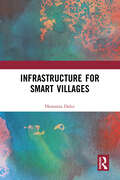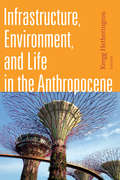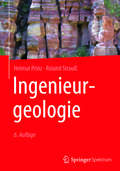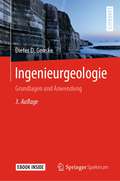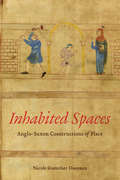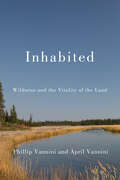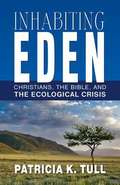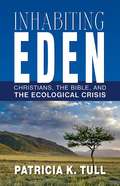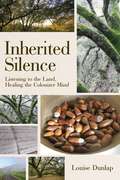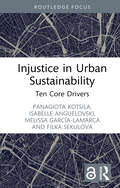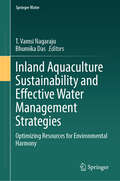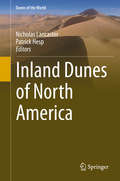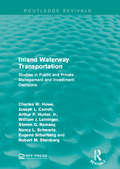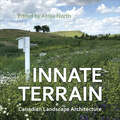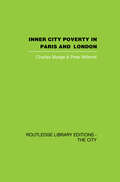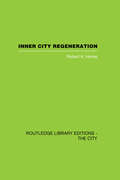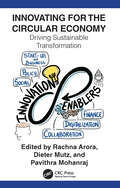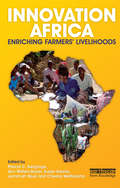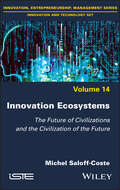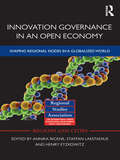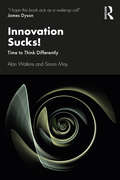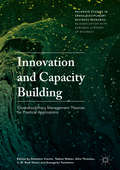- Table View
- List View
Infrastructure for Smart Villages
by Hemanta DoloiThis book intends to initiate a fresh articulation of need-based infrastructure provisions in rural contexts. Departing from the conventional theories and practices of infrastructure planning and development applied in urban settings, the book presents a comprehensive suite of technical and non-technical indicators that rationalise fit-for-purpose planning, development, and operations of rural infrastructure. Drawing from global practices in public and private sectors and research-based evidence, a distinctive argument is put forward for promoting location-specific infrastructure development from effectiveness, practicality, affordability, and sustainability perspectives. The argument encompasses wider social, cultural, and economic contexts that are unique to rural settings and the book highlights a clear roadmap of how the UN’s sustainable development goals (SDGs) are at the core of developing rural communities with necessary infrastructure provisions that are purpose-built, affordable, risk averse, and resilient.This book will provide an overview of some of the little-understood and sometimes counter-intuitive best practices on rural infrastructure and value-based priorities that have emerged in uplifting rural communities in developing economies over the last 30 years. Drawing from the global literature and practice-based evidence across a complete spectrum of relevant disciplines, this book will provide readers with a clear articulation of the innovative ideas around harnessing rural potential, and empowering rural communities with added support in growth and progressive development in the context of interconnected infrastructure systems and improved living standards. It is key reading for development, planning, and infrastructure courses as well as professionals and researchers involved in international development, aid, and provision in rural areas.
Infrastructure, Environment, and Life in the Anthropocene (Experimental Futures)
by Kregg HetheringtonInfrastructure, Environment, and Life in the Anthropocene explores life in the age of climate change through a series of infrastructural puzzles—sites at which it has become impossible to disentangle the natural from the built environment. With topics ranging from breakwaters built of oysters, underground rivers made by leaky pipes, and architecture gone weedy to neighborhoods partially submerged by rising tides, the contributors explore situations that destabilize the concepts we once relied on to address environmental challenges. They take up the challenge that the Anthropocene poses both to life on the planet and to our social-scientific understanding of it by showing how past conceptions of environment and progress have become unmoored and what this means for how we imagine the future. Contributors. Nikhil Anand, Andrea Ballestero, Bruce Braun, Ashley Carse, Gastón R. Gordillo, Kregg Hetherington, Casper Bruun Jensen, Joseph Masco, Shaylih Muehlmann, Natasha Myers, Stephanie Wakefield, Austin Zeiderman
Infrastrukturmaßnahmen für den alpenquerenden und inneralpinen Gütertransport: Eine europarechtliche Analyse vor dem Hintergrund der Alpenkonvention
by Jennifer HeuckDas steigende Güterverkehrsaufkommen in der Europäischen Union führt zu Umweltbeeinträchtigungen, von denen der Alpenraum in besonderem Maße betroffen ist. Das vorliegende Werk geht der Frage nach, wie dem unter Berücksichtigung der Grundfreiheiten der Europäischen Union - insbesondere des freien Warenverkehrs - durch gezielte rechtliche Maßnahmen begegnet werden kann. Zentrale Bedeutung kommt dabei den rechtlichen Bestimmungen zur Errichtung und Nutzung von Infrastrukturen für den alpenquerenden und inneralpinen Güterverkehr zu, insbesondere der Alpenkonvention - einem völkerrechtlichen Abkommen zum Schutz und Erhalt der Alpen - und ihrem Verkehrsprotokoll, deren Vertrags- bzw. Unterzeichnerparteien die Europäische Union sowie die acht Alpenstaaten sind. Die Alpenkonvention und das Verkehrsprotokoll werden in dem Werk erstmals umfassend dargestellt und analysiert. Schließlich zeigt die Untersuchung, welche rechtlichen Wirkungen das Verkehrsprotokoll, das die Europäische Union bisher lediglich unterzeichnet hat, im Falle seiner Ratifikation für die Europäische Union entfalten würde.
Ingenieurgeologie
by Helmut Prinz Roland StraußDer "Abriss der Ingenieurgeologie", wie das Buch bisher hieß, hat sich in vier Auflagen bestens bewährt, sowohl für Studierende als auch im Beruf stehende Geologen und Bauingenieure. Die Neuauflage wurde an vielen Stellen modernisiert und erweitert, v. a. wieder die Kapitel über Gesteins- und Gebirgsbeschreibung sowie über Tunnelbau. Mit den Bergbaufolgen wurde ein weiteres hochaktuelles Thema ganz neu aufgenommen. In allen Kapiteln wurden die aktuellen strukturellen Umbrüche in der europäischen und internationalen Standardisierung berücksichtigt.
Ingenieurgeologie: Grundlagen und Anwendung
by Dieter D. GenskeDie Ingenieurgeologie befasst sich mit Georisiken und diskutiert die Folgen menschlicher Eingriffe im Schnittbereich der Geo- und Ingenieurwissenschaften. Dazu zählen Naturgefahren wie Steinschlag, Bergstürze und Bergsenkungen, aber auch das sichere und wirtschaftliche Bauen, die Kartierung von Altlasten und die Sanierung von Bergbaufolgelandschaften. Die dritte Auflage ist vollständig überarbeitet und um weitere aktuelle Themen wie die Endlagerung radioaktiver Abfälle, die nachhaltige Nutzung von Rohstoffen, die Energiewende und die Herausforderungen des Klimawandels erweitert.In diesem Buch werden die grundlegenden Prinzipien, von der Erkundung des Terrains bis zur selbstständigen Lösung komplexer ingenieurgeologischer Aufgaben vorgestellt. Zahlreiche Praxisbeispiele wie das Bahnprojekt Stuttgart21 oder die havarierten Reaktoren von Fukushima veranschaulichen die zum Teil komplexen geotechnischen Zusammenhänge. Rund hundert ausgearbeitete Übungsaufgaben ermöglichen ein selbstständiges Erlernen der Lösungswege und Nachweise. Auch ingenieurgeologische Utopien werden angesprochen, von denen einige in den Bereich des Machbaren rücken, wie etwa ein Tunnel durch den Atlantik, bewohnbare Inseln aus Plastikmüll oder Türme, die Höhenrekorde brechen. Das mit zahlreichen Diagrammen, Schaubildern, Zeichnungen und Fotos hervorragend illustrierte Buch ist sowohl für Ingenieure als auch für Geowissenschaftler, sowohl für Studierende als auch für Praktiker geschrieben.
Inhabited Spaces: Anglo-Saxon Constructions of Place
by Nicole DiscenzaWe tend to think of early medieval people as unsophisticated about geography because their understandings of space and place often differed from ours, yet theirs were no less complex. Anglo-Saxons conceived of themselves as living at the centre of a cosmos that combined order and plenitude, two principles in a constant state of tension. In Inhabited Spaces, Nicole Guenther Discenza examines a variety of Anglo-Latin and Old English texts to shed light on Anglo-Saxon understandings of space. Anglo-Saxon models of the universe featured a spherical earth at the centre of a spherical universe ordered by God. They sought to shape the universe into knowable places, from where the earth stood in the cosmos, to the kingdoms of different peoples, and to the intimacy of the hall. Discenza argues that Anglo-Saxon works both construct orderly place and illuminate the limits of human spatial control.
Inhabited: Wildness and the Vitality of the Land
by Phillip Vannini April VanniniPeople are key elements of wild places. At the same time, human entanglements with wild ecologies involve extractivism, the growth of resource-based economies, and imperial-colonial expansion, activities that are wreaking havoc on our planet.Through an ethnographic exploration of Canada’s ten UNESCO Natural World Heritage sites, Inhabited reflects on the meanings of wildness, wilderness, and natural heritage. As we are introduced to local inhabitants and their perspectives, Phillip Vannini and April Vannini ask us to reflect on the colonial and dualist assumptions behind the received meaning of wild, challenging us to reimagine wildness as relational and rooted in vitality. Over the three years they spent in and around these sites, they learned from Indigenous and non-Indigenous peoples about their entanglements with each other and with non-human animals, rocks, plants, trees, sky, water, and spirits. The stories, actions, and experiences they encountered challenge conventional narratives of wild places as uninhabited by people and disconnected from culture and society. While it might be tempting to dismiss the idea of wildness as outdated in the Anthropocene era, Inhabited suggests that rethinking wildness offers a better – if messier – way forward.Part geography and anthropology, part environmental and cultural studies, and part politics and ecology, Inhabited balances a genuine love of nature’s vitality with a culturally responsible understanding of its interconnectedness with more-than-human ways of life.
Inhabiting Eden
by Patricia K. TullIn this thoughtful study, respected Old Testament scholar Patricia K. Tull explores the Scriptures for guidance on today's ecological crisis. Tull looks to the Bible for what it can tell us about our relationships, not just to the earth itself, but also to plant and animal life, to each other, to descendants who will inherit the planet from us, and to our Creator. She offers candid discussions on many current ecological problems that humans contribute to, such as the overuse of energy resources like gas and electricity, consumerism, food production systems--including land use and factory farming--and toxic waste. Each chapter concludes with discussion questions and a practical exercise, making it ideal for both group and individual study. This important book provides a biblical basis for thinking about our world differently and prompts us to consider changing our own actions. Visit inhabitingeden. org for links to additional resources and information.
Inhabiting Eden: Christians, the Bible, and the Ecological Crisis
by Patricia K. TullIn this thoughtful study, respected Old Testament scholar Patricia K. Tull explores the Scriptures for guidance on today's ecological crisis. Tull looks to the Bible for what it can tell us about our relationships, not just to the earth itself, but also to plant and animal life, to each other, to descendants who will inherit the planet from us, and to our Creator. She offers candid discussions on many current ecological problems that humans contribute to, such as the overuse of energy resources like gas and electricity, consumerism, food production systems--including land use and factory farming--and toxic waste. Each chapter concludes with discussion questions and a practical exercise, making it ideal for both group and individual study. This important book provides a biblical basis for thinking about our world differently and prompts us to consider changing our own actions. Visit inhabitingeden.org for links to additional resources and information.
Inherited Silence: Listening to the Land, Healing the Colonizer Mind
by Louise DunlapAn insightful look at the historical damages early colonizers of America caused and how their descendants may recognize and heal the harm done to the earth and the native peoplesInherited Silence tells the story of beloved land in California’s Napa Valley—how the land fared during the onslaught of colonization and how it fares now in the drought, development, and wildfires that are the consequences of the colonial mind. Author Louise Dunlap’s ancestors were among the first Europeans to claim ownership of traditional lands of the Wappo people during a period of genocide. As settlers, her ancestors lived the dream of Manifest Destiny, their consciousness changing only gradually over the generations.When Dunlap’s generation inherited the land, she had already begun to wonder about its unspoken story. What had kept her ancestors from seeing and telling the truth of their history? What had they brought west with them from the very earliest colonial experience in New England? Dunlap looks back into California’s and America’s history for the key to their silences and a way to heal the wounds of the land, its original people, and the harmful mind of the colonizer.It’s a powerful story that will awaken others to consider their own ancestors’ role in colonization and encourage them to begin reparations for the harmful actions of those who came before. More broadly, it offers a way for every reader to evaluate their own current life actions and the lasting impact they can have on society and our planet.
Injustice in Urban Sustainability: Ten Core Drivers (Routledge Equity, Justice and the Sustainable City series)
by Isabelle Anguelovski Panagiota Kotsila Melissa García-Lamarca Filka SekulovaThis book uses a unique typology of ten core drivers of injustice to explore and question common assumptions around what urban sustainability means, how it can be implemented, and how it is manifested in or driven by urban interventions that hinge on claims of sustainability. Aligned with critical environmental justice studies, the book highlights the contradictions of urban sustainability in relation to justice. It argues that urban neighbourhoods cannot be greener, more sustainable and liveable unless their communities are strengthened by the protection of the right to housing, public space, infrastructure and healthy amenities. Linked to the individual drivers, ten short empirical case studies from across Europe and North America provide a systematic analysis of research, policy and practice conducted under urban sustainability agendas in cities such as Barcelona, Glasgow, Athens, Boston and Montréal, and show how social and environmental justice is, or is not, being taken into account. By doing so, the book uncovers the risks of continuing urban sustainability agendas while ignoring, and therefore perpetuating, systemic drivers of inequity and injustice operating within and outside of the city. Accessibly written for students in urban studies, critical geography and planning, this is a useful and analytical synthesis of issues relating to urban sustainability, environmental and social justice.
Inland Aquaculture Sustainability and Effective Water Management Strategies: Optimizing Resources for Environmental Harmony (Springer Water)
by T. Vamsi Nagaraju Bhumika DasThis book attempts to unlock the intricacies of transforming inland aquaculture into a beacon of sustainability with this indispensable guide. It outlines the challenges ahead and presents many innovative strategies to overcome them, ensuring a future where aquaculture contributes positively to environmental, social, and economic well-being. With a focus on the pivotal role of water management, this book offers a comprehensive toolkit of solutions, ranging from cutting-edge technologies like remote sensing and machine learning to integrating IoT and renewable energy, all aimed at optimizing resource use and minimizing environmental impacts. It goes beyond the technical aspects to delve into the heart of sustainability, exploring the socio-economic dimensions crucial for successful aquaculture operations. This guide serves as a roadmap for stakeholders at all levels, providing insights into sustainable feed and nutrition, eco-friendly construction, and effective waste management while addressing the need for resilience against climate change. This book does more than predict the future; it does so by drawing from an extensive array of case studies and research. Nevertheless, it provides you with the necessary components to make it, which makes it a vital tool for anybody devoted to the long-term advancement of inland aquaculture. Accept this advice to pave the way for a more robust, productive, and sustainable aquaculture environment.
Inland Dunes of North America (Dunes of the World)
by Nicholas Lancaster Patrick HespInland sand dunes are widespread in North America and are found from the North Slope of Alaska to the Sonoran Desert in northern Mexico and from the Delmarva Peninsula in the east to Southern California in the west. In this edited book, we highlight recent research on areas of inland dunes that span a range from those that are actively accumulating in current conditions of climate and sediment supply to those that were formed in past conditions and are now degraded relict systems. This book will be of interest to researchers and scholars of physical geography, geomorphology, environmental sciences, and earth sciences. Contributions include detailed analyses of individual active dune systems at White Sands, New Mexico; Great Sand Dunes, Colorado; and the Laurentian Great Lakes; as well as the vegetation-stabilized dunes of the Nebraska Sand Hills and the Colorado Plateau. Additional chapters discuss the widespread partially vegetated dune systems of the central and southern Great Plains; the relict dunes of the Atlantic Coastal Plain of the eastern USA; and active and stabilized dunes of the Colorado Plateau and the southwestern deserts of the USA and northern Mexico.
Inland Waterway Transportation: Studies in Public and Private Management and Investment Decisions (Routledge Revivals)
by Nancy L. Schwartz Charles W. Howe Joseph L. Carroll Arthur P. Hurter, Jr. William J. Leininger Steven G. Ramsey Eugene Silberberg Robert M. SteinbergInland Waterway Transportation explores how tools of economic analysis can improve the efficiency of both public and private investment in inland waterway transportation. Originally published in 1969, this study investigates how waterway transportation has been affected by public operating policy, costs and charges for the use of waterways in the United States as well as the impact of relationships central to waterway policy and individual firms such as the effect of the waterway environment on a firm’s efficiency. This title will be of interest to students of Environmental Studies and professionals.
Innate Terrain: Canadian Landscape Architecture
by Alissa NorthInnate Terrain addresses the varied perceptions of Canada’s natural terrain, framing the discussion in the context of landscapes designed by Canadian landscape architects. This edited collection draws on contemporary works to theorize a distinct approach practiced by Canadian landscape architects from across the country. The essays – authored by Canadian scholars and practitioners, some of whom are Indigenous or have worked closely with Indigenous communities – are united by the argument that Canadian landscape architecture is intrinsically linked to the innate qualities of the surrounding terrain. Beautifully illustrated, Innate Terrain aims to capture distinct regional qualities that are rooted in the broader context of the Canadian landscape.
Inner City Poverty in Paris and London
by Charles Madge Peter WillmottBoth the great cities studied in this book are renowned for their imposing streets and buildings, their cultural and political vitality and their cosmopolitan lifestyles, but just outside their centres are neighbourhoods where ordinairy people have their homes, often living in poverty and sometimes in squalor. Two such neighbourhoods were Stockwell in London and Folie-Mericourt in Paris, and are the tale of this 'tale of two cities' told by social researchers. The local studies are set in their broader metropolitan and national contexts, including an examination of changes over time in income patterns in France and Britain and in housing policies in the metropolitan regions. This illuminates the effects of different social policies adopted by Britain and France, Paris and London, to help poor and disadvantaged families. This book was first published in 1981.
Inner City Regeneration
by Robert K. HomeThis book covers all the main aspects of government policy and practice in British inner city regeneration. Chapters deal with the development of policy, agencies for regeneration, housing, social issues. The UK edxperience is compared with that of other countries, particularly the USA, and past achievements and future prospects are considered. This book was first published in 1982.
Innovating Climate Governance: Moving Beyond Experiments
by Bruno Turnheim Paula Kivimaa Frans BerkhoutAfter the perceived failure of global approaches to tackling climate change, enthusiasm for local climate initiatives has blossomed worldwide, suggesting a more experimental approach to climate governance. Innovating Climate Governance: Moving Beyond Experiments looks critically at climate governance experimentation, focusing on how experimental outcomes become embedded in practices, rules and norms. Policy which encourages local action on climate change rather than global burden sharing suggests a radically different approach to tackling climate issues. This volume reflects on what climate governance experiments achieve, as well as what happens after and beyond these experiments. A bottom-up, polycentric approach is analysed, exploring the outcomes of climate experiments and how they can have broader, transformative effects in society. Contributions offer a wide range of approaches and cover more than fifty empirical cases internationally, making this an ideal resource for academics and practitioners involved in studying, developing and evaluating climate governance.
Innovating for The Circular Economy: Driving Sustainable Transformation
by Rachna Arora, Dieter Mutz, and Pavithra MohanrajSystemic change is required to move to a circular economy (CE) model which can meet the demands of a growing population in a manner that is decoupled from resource use and waste generation. This book takes a deep dive into the innovation aspect of the circular economy (CE), with a specific focus on India as a geography, where the transformation to a circular economy is underway. How a developing country like India is tackling the complexities of the transformation and creating innovative solutions is showcased in this book through many practical examples and inspirational case studies. The book lays out the foundations for mainstreaming resource efficiency (RE)/CE in India, and covers innovation led by businesses and start-ups, along with the innovative policies, financing, and collaborative models required to spur and accelerate circular economy approaches, while also providing linkages to the international context. Features: Provides insight into the role of innovation in the circular economy transition Helps to develop and facilitate adoption of resource-efficiency policy and strategy with particular focus on key resource sectors and waste streams Treats the circular economy as a holistic approach across the entire lifecycle, and places emphasis on upstream interventions and systems change Examines the current context of COVID-19 and its impact on circular economy models and practices Touches upon how the EU-based approach was adapted and contextualised significantly to work in the unique Indian landscape This book is aimed at students, researchers, and professionals engaged in the domains of circular economy, sustainability, business innovation, environmental studies, natural resources management, and environmental and resource conservation policy.
Innovating in Urban Economies
by David A. WolfeIn a globalizing, knowledge-based economy, innovation and creative capacity lead to economic prosperity. Starting in 2006, the Innovation Systems Research Network began a six year-long study on how city-regions in Canada were surviving and thriving in a globalized world. That study resulted in the "Innovation, Creativity, and Governance in Canadian City-Regions" series, which examines the impact of innovation, talent, and institutions on sixteen city-regions across Canada. This volume explores how the social dynamics that influence innovation and knowledge flows in Canadian city-regions contribute to transformation and long-term growth.With case studies examining cities of all sizes, from Toronto to Moncton, Innovating in Urban Economies analyzes the impact of size, location, and the regional economy on innovation and knowledge in Canada's cities.
Innovation Africa: Enriching Farmers' Livelihoods
by Jemimah Njuki Pascal C. Sanginga Ann Waters-Bayer Susan Kaaria Chesha WettasinhaAgricultural research, extension and education can contribute greatly to enhancing agricultural production in a sustainable way and to reducing poverty in the developing world, but achievements have generally fallen short of expectations in Africa. In recent years, growing economic and demographic pressures - coupled with the entry of new market forces and actors - have created a need and an opportunity for more interactive approaches to development. Understanding the existing innovation processes, recognizing the potential for catalysing them and learning how to support joint innovation by different groups will be the key to success. This book covers new conceptual and methodological developments in agricultural innovation systems, and showcases recent on-the-ground experiences in different contexts in Africa. The contributions show how innovation is the outcome of social learning through interaction of individuals and organizations in both creating and applying knowledge. It brings examples of how space and incentives have been created to promote collaboration between farmers, research, extension and the private sector to develop better technologies and institutional arrangements that can alleviate poverty. In 25 broad-ranging chapters the book reflects cutting-edge thinking and practice in support of innovation processes in agriculture and management of natural resources.
Innovation Ecosystems: The Future of Civilizations and the Civilization of the Future
by Michel Saloff-CosteOur current situation, marked simultaneously by the Anthropocene, global warming, digitization and exponential artificial intelligence, leads us to sudden and total change in global civilization and, de facto, to rebuilding the foundations of the international economy. Innovation Ecosystems explores the risks and opportunities facing the contemporary world by analyzing, comparing and categorizing the world&’s most dynamic innovation ecosystems by region and city. This includes the identification of key characteristics – common or original – and learning from them in terms of culture, management, system and structure, in order to meet current challenges and think about civilizations of the future.
Innovation Governance in an Open Economy: Shaping Regional Nodes in a Globalized World (Regions and Cities)
by Henry Etzkowitz Annika Rickne Staffan LaestadiusIn an increasingly globalised world, paradoxically regional innovation clusters have moved to the forefront of attention as a strategy for economic and social development. Transcending international success cases, like Silicon Valley and Route 128, as sources of lessons, successful high tech clusters in niche areas have had a significant impact on peripheral regions. Are these successful innovation clusters born or made? If they are subject to planning and direction, what is the shape that it takes: top down, bottom up or lateral?
Innovation Sucks!: Time to Think Differently
by Simon May Alan WatkinsBusinesses spend billions on innovation with very little to show for their investment or effort. This book challenges some of the ‘ingrained truths’ of innovation and suggests a different approach. Innovation is not the creation of a novel idea. It is the successful commercialisation of that novel idea. Rather than starting with a costly, time-consuming problem assessment that seeks to push potential solutions through an innovation funnel, an ‘impeller approach’ starts with possible solutions and gets the market to pull the best ones forward so they can fail fast or flourish fast. This approach is made possible by the addition of a ‘bee’ – a new type of integrative thinker who can harvest the existing knowledge from the ‘meadow of experts’. Completely reversing the innovation process means organisations are much better placed to win in the market rather than focusing on finding theoretical solutions or clearing innovation stage gates. In addition, this approach also recognises that the people who shepherd the solution through the ideation and testing stage are not the same people who must then take that solution to market for successful commercialisation. Given the current innovation failure rate, coupled with the fact that society is beset with multiple wicked problems, it’s time to think differently and innovate innovation itself. This book is essential reading for Heads of Innovation and Commercialisation, Directors of Marketing, Heads of New Product Development and New Service Development, Strategy Directors, Chief Technology Officers, Government advisers and policy makers.
Innovation and Capacity Building: Cross-disciplinary Management Theories for Practical Applications (Palgrave Studies in Cross-disciplinary Business Research, In Association with EuroMed Academy of Business)
by Demetris Vrontis Yaakov Weber Alkis Thrassou S. M. Shams Evangelos TsoukatosThis book explores how contemporary organisations are abandoning conventional tactics in order to survive and grow in an incessantly shifting business landscape, analysing fundamental aspects of management, marketing and strategy from an interdisciplinary perspective. Focusing on the paradigms of neuro-marketing, innovative change management, motivational creativity, and customer data management, to name a few, the authors provide practical learning outcomes which reflect how organisations are seeking to adopt innovative means to innovative ends, targeting capacity building in multiple ways. Ultimately, this edited collection implicitly defines an organisational philosophy that incorporates functionality, but also embraces business notions pertaining to wider contextual transformations and environmental developments. Theoretical and practical contributions highlight the importance of multidisciplinary research to practical business success, making this book an invaluable read to both scholars and business executives.
